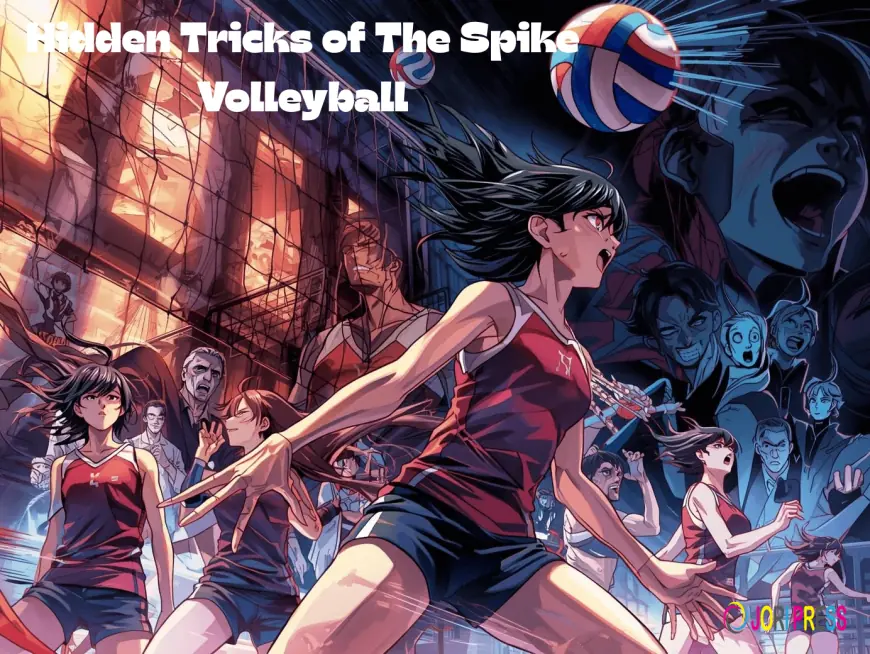Mastering the Spike: Survive the Deadliest Obstacle in Slope
The article explains how to deal with the spike — the hardest obstacle in the 3D arcade game Slope. It describes why spikes are dangerous, how they appear suddenly, and why many players crash into them.

If you’ve ever played Slope, you already know that it’s not just another endless-running arcade game. It’s fast, intense, and full of surprises. The moment you start rolling that shiny green ball down a steep 3D slope, your heart starts racing. The speed builds up, the obstacles appear faster, and before you know it—you’re dodging walls, jumping gaps, and spinning around corners, hoping not to crash.
Among all these challenges, one obstacle stands out as the most feared and frustrating of all — the spike.
Many players call it the “silent killer” of Slope because it appears suddenly, gives you almost no time to react, and ends your run in a split second.
But don’t worry! In this guide, we’ll talk about everything you need to know about the spike — what it is, why it’s so dangerous, and most importantly, how you can master it. Whether you’re a beginner trying to survive for more than 30 seconds or a seasoned player chasing high scores, these tips will help you improve your reflexes and confidence.
What Is the Spike in Slope?
The spike is one of the many obstacles you’ll face while rolling down the slope. It’s usually shaped like a tall, pointed triangle sticking out of the floor or the side of a ramp. Sometimes, it appears alone, but often it’s placed right after a turn or between two narrow platforms, making it extra tricky.
If your ball touches the spike — even slightly — it’s game over. There’s no second chance, no recovery. You’ll have to start all over again. That’s what makes it such a tough challenge.
Unlike walls or gaps that you can see coming from far away, spikes often appear at the last moment, especially when the slope is curving or when your speed is very high. That’s why so many players crash into them — not because they don’t see them, but because they react too late.
Why the Spike Is So Dangerous
There are a few reasons why spikes cause so much trouble for players:
-
They blend into the environment.
In Slope, everything is shiny and moving fast. The background, platforms, and ramps are all made of geometric patterns. Spikes sometimes have the same color tone as the floor, making them harder to spot. -
The speed keeps increasing.
The longer you survive, the faster your ball rolls. What feels like a calm start quickly turns into lightning-speed chaos. At that pace, even a small movement can mean the difference between life and death. -
They appear at tricky spots.
Spikes are often placed right after a curve, in narrow lanes, or near moving platforms. This means you can’t always predict where they’ll show up. Sometimes, you dodge a wall successfully only to crash into a spike immediately afterward. -
There’s no margin for error.
You can bump lightly into walls and survive, but spikes are unforgiving. Even the smallest touch will destroy your ball instantly.
Understanding the Game Physics
Before you learn how to avoid spikes, it helps to understand how Slope’s physics work. The game uses smooth and continuous motion — your ball doesn’t stop unless it hits something. When you move left or right, you’re not just sliding; you’re actually controlling the direction and momentum of a rolling ball on a slanted surface.
That means the more sharply you turn, the more likely you are to lose control or fall off the edge. Smooth, small movements are much better than sudden ones.
This is especially true when spikes are nearby — you’ll need to control your direction precisely without oversteering.
Tips to Avoid the Spike
Now let’s get into the practical part — how to survive those deadly spikes and keep rolling longer.
1. Focus your eyes ahead, not on the ball
One of the biggest mistakes new players make is staring at the ball instead of the track ahead. You need to train your eyes to look a little further down the slope — about two or three sections ahead. This gives your brain time to process what’s coming and react before it’s too late.
When you see a spike coming, you’ll already have a plan on how to dodge it.
2. Use small, controlled movements
Panicking and swinging your ball too hard to one side will usually make things worse. Gentle, controlled movements help you stay in the middle of the track and react smoothly to obstacles. Remember: in Slope, balance is everything.
3. Learn the patterns
Even though Slope feels random, the game actually has repeating patterns of obstacles. By playing often, you’ll start to recognize these patterns — like when a spike usually appears after a curve or near a gap. Once you learn them, you can anticipate the spike before it even appears.
4. Stay in the center of the track
This is one of the best defensive strategies in Slope. The center lane gives you more time to move left or right if something suddenly appears. If you stick too close to the edges, you’ll have less space to dodge spikes or walls.
5. Don’t rush turns
It’s tempting to swing quickly around corners, especially when you’re at high speed. But sharp turns can throw your ball off balance and send you straight into a spike waiting on the next platform. Take turns with care, keeping your motion smooth and predictable.
6. Practice timing and rhythm
Slope is all about rhythm — moving left and right in a steady flow. Try to feel the pace of the game. Once you find your rhythm, it’s much easier to dodge obstacles smoothly without panicking.
7. Don’t get distracted by colors or lights
The bright 3D visuals can sometimes make it hard to see what’s happening. Ignore the flashy background and focus only on the ramps and obstacles. Keeping your eyes on the path is key to survival.
Dealing With Spikes at Higher Speeds
When your ball starts moving extremely fast, it’s normal to feel overwhelmed. But don’t worry — every expert player has been there. Here’s how you can handle spikes when things speed up:
-
Use peripheral vision. Try to sense motion on the sides of your screen instead of focusing only on the center. This helps you detect spikes faster.
-
Make tiny adjustments. At high speeds, small movements go a long way. Tapping your controls lightly is better than holding them down.
-
Stay calm. Panicking causes overcorrection, which often leads to crashing into a wall or spike. Take a deep breath and move with the flow of the game.
Common Mistakes Players Make
Let’s look at some of the common errors players make when facing spikes — and how you can avoid them.
-
Turning too late.
By the time you react, your ball has already hit the spike. The fix? Look ahead, not at your ball. -
Oversteering.
Swinging too far to dodge a spike can cause you to fall off the edge. Keep your movements small and controlled. -
Panicking after a close call.
After narrowly escaping an obstacle, players often lose focus and crash into the next one. Stay calm and reset your focus immediately after every dodge. -
Ignoring practice.
The more you play, the better your reflexes become. There’s no shortcut — mastering the spike takes time and patience.
Mental Focus and Flow State
Avoiding spikes isn’t just about fast fingers — it’s about mental focus. The best Slope players describe being in a “flow state,” where they stop overthinking and just react naturally. Their eyes see, their fingers move, and everything feels automatic.
To reach that level, try playing in a quiet environment, free from distractions. Turn up the in-game music or your favorite playlist — it helps you find rhythm. And remember: don’t chase the high score too hard. Focus on improving your control, and the scores will follow.
Training Exercises to Improve Reflexes
If you want to become a true Slope master, try these fun little exercises:
-
Short practice runs – Instead of always going for long runs, practice surviving the first 30 seconds multiple times. This builds quick reflexes.
-
Mirror training – Try switching directions quickly to simulate dodging spikes from different angles.
-
Speed focus – Once you’re comfortable at lower speeds, intentionally push yourself to survive at higher ones. It trains your reaction time.
-
Relaxed play – Some sessions, just focus on staying calm rather than scoring. Learning to relax under pressure is key.
The Psychology of the Spike
It’s funny how such a simple obstacle can have such a powerful effect. The spike doesn’t move or chase you — it just sits there, waiting. But it plays a big psychological trick. Because it ends your game instantly, players fear it. That fear causes hesitation — and hesitation leads to mistakes.
The key is to reframe how you see the spike. Instead of viewing it as your enemy, treat it as a teacher. Every time you crash into one, you learn something: where to look, how to turn, or when to slow down. Each run makes you better.
Remember: every great player has hit hundreds of spikes before mastering the game. Failing is part of the process.
Advanced Techniques for Experts
Once you’ve gotten comfortable with the basics, you can start experimenting with more advanced strategies:
-
Predictive dodging: Move early when you sense a spike might appear after a curve.
-
Momentum control: Slightly tap in the opposite direction to slow your turning momentum when approaching narrow lanes.
-
Platform scanning: Use the top of your screen to spot the next ramp early — spikes often appear right at the start of new platforms.
-
Angle mastery: Learn how sharp you can safely turn without sliding off; this helps when spikes appear close to walls.
These advanced techniques take practice, but once you master them, spikes will no longer scare you.
Why Mastering the Spike Matters
You might wonder — why focus so much on one obstacle? The reason is simple: the spike teaches you everything about Slope.
To dodge spikes, you must be alert, patient, and precise — the three skills that define expert players.
If you can master the spike, you can handle anything else the game throws at you. Walls, gaps, turns — they’ll all feel easier once you’ve trained your mind and reflexes against the deadliest obstacle in the game.
Final Thoughts
The spike in Slope might seem impossible to beat at first, but with time, focus, and practice, you’ll learn to glide past it with confidence. Every crash is a step toward improvement. Every failed run teaches you something new about timing and control.
So, the next time you see that sharp triangle ahead, don’t panic. Smile — because you know it’s just another chance to prove your skills. Keep rolling, stay centered, and trust your reflexes. Before long, you’ll find yourself flying past spikes that once seemed unbeatable. In Slope, survival isn’t about perfection — it’s about persistence.
And once you master the spike, you’ll realize that the real thrill isn’t just in surviving — it’s in learning how to stay calm in chaos.
What's Your Reaction?
 Like
0
Like
0
 Dislike
0
Dislike
0
 Love
0
Love
0
 Funny
0
Funny
0
 Angry
0
Angry
0
 Sad
0
Sad
0
 Wow
0
Wow
0















































